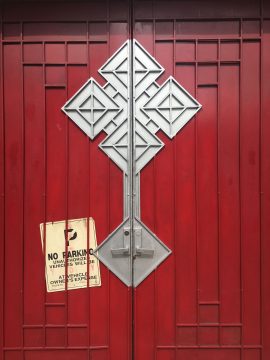
Mural of Ethiopan Cross Photo credit: Africa Access
Location: Arkansas & 14th Streets, NW Washington, DC
A mural of an Ethiopian cross is painted on the rear of Debre Selam Kidist Mariam Church- Ethiopian Orthodox Church.
“Christianity has a long history in Ethiopia, dating from its introduction in Aksum under the reign of King Azana in about A.D. 330. Its spread among the peoples of the highlands, and the arrival of nine monks from Syria toward the end of the fifth century, is said to have introduced monasticism to Ethiopia and to have contributed strongly to the production and use of liturgical objects. The cross is perhaps the most pervasive symbolic artifact. Every member of the clergy carries a cross at all times. The most beautiful and intricate are the processional crosses used in ceremonies and festivals throughout the liturgical calendar. They are mounted on long poles and sheltered by canopies and parasols of silk and velvet. This cross, dating from the 15th century, was cast in one piece from a copper alloy. Later crosses, for which the favored material was brass, typically have separate arms and shafts joined with rivets. The cross has lobes filled with crosses formed from diamond shapes surrounding a central Maltese cross” (Museum of African Art).
“Christianity most likely arrived in Ethiopia in the first century. The conversion of King Ezana in 330 c.e. led to its official acceptance and the minting of coins bearing one of the earliest uses of the cross as a Christian symbol. Although the silver pendant crosses in the Museum’s collection are from the nineteenth and twentieth centuries, their forms have a considerably longer history, as the much older copper, wood, and iron crosses here demonstrate.
Hand crosses, which are used by priests, are either hand-held or suspended from a cord around the neck. They are kissed by the faithful to receive a blessing. Processional crosses are carried on long poles in religious processions. Prayer staffs are used to mark rhythms during sacred dances and as supports to lean on while standing for long hours during Orthodox church services. Together, all of these crosses are emblems of the Ethiopian Orthodox church’s ongoing authority” (Brooklynmuseum.org.)
Resources
“Hand crosses. Brooklyn Museum. https://www.brooklynmuseum.org/ Accessed 9/15/2020.
“Processional cross.” National Museum of African Art. africasi.edu Accessed 9/15/2020.
